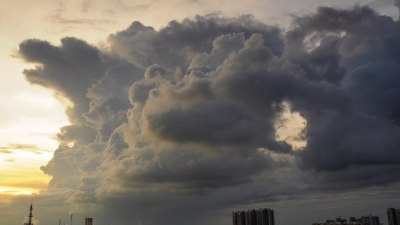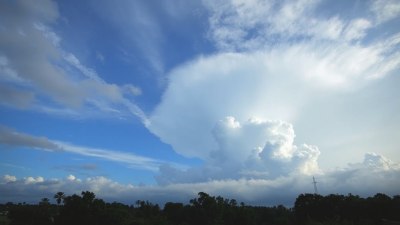The Most Dangerous Cloud You Will Ever See The Anvil Cloud
Discover the terrifying beauty of anvil clouds and their potential dangers.

Anvil clouds, often seen extending from towering thunderheads, represent one of nature's most striking displays. However, their beauty can mask a multitude of dangers that meteorologists and storm enthusiasts are all too aware of. In this article, we'll delve into the formation, structure, and hazards associated with anvil clouds, shedding light on why they are considered one of the most dangerous cloud types you can encounter.
What Are Anvil Clouds?
Anvil clouds, scientifically classified as part of the cumulonimbus cloud family, are easily recognizable due to their flat tops that resemble a hammer, hence their name. This flat top, or anvil, forms when the rising air within the cumulonimbus reaches the stable layer of the atmosphere, causing it to spread out. Anvil clouds can develop in conjunction with severe thunderstorms and are often a precursor to extreme weather conditions.
Formation of Anvil Clouds
The formation of anvil clouds begins with the development of cumulonimbus clouds, which are tall, vertically developed clouds associated with thunderstorms. When warm, moist air rises rapidly, it cools and condenses into water droplets, forming cumulus clouds. As this process continues, the cloud grows taller and when it reaches a certain height, typically around 10,000-12,000 feet, it hits a layer of stable air known as the tropopause. Here, it spreads out, creating the anvil shape that is characteristic of these clouds.
Structure of Anvil Clouds
Anvil clouds are interesting in terms of their structure. The anvil part can be made up of ice crystals, particularly at high altitudes where temperatures are extremely low. Underneath this icy expanse is often a tumultuous mixture of warm, moist air and turbulent conditions that spawn heavy rainfall, lightning, hail, and even tornadoes. The height of an anvil cloud can vary dramatically, but it typically ranges from 20,000 feet to upwards of 60,000 feet, especially in severe thunderstorms.
Weather Phenomena Associated with Anvil Clouds
Anvil clouds are closely associated with severe weather phenomena. The towering thunderstorms that generate them can bring violent storms, causing significant damage. Below the anvil, strong downdrafts can lead to heavy rain, flash flooding, and damaging winds. Furthermore, these storms often produce notorious hailstorms that can wreak havoc on property and agriculture. The ice crystals that form within the anvil can also lead to deadly lightning strikes, making these storms especially dangerous.
Lightning and Anvil Clouds
One of the most feared phenomena associated with anvil clouds is lightning. Anvil clouds can produce an incredible amount of electrical activity, especially in severe thunderstorms. This is due to the collision of ice particles within the cloud, resulting in the build-up of electrical charge. The resulting lightning can strike miles away from the parent cloud, often catching unsuspecting individuals off guard. Ground strikes can be deadly, highlighting the potential dangers of being outdoors during such storms.
Hail and Anvil Clouds
The relationship between anvil clouds and hail is another dangerous aspect of these storm systems. Hail forms in strong updrafts within the thunderstorms associated with anvil clouds. As water droplets are lifted high into the cold regions of the storm, they freeze and eventually fall back to the warmer areas of the cloud. This process can occur multiple times, creating larger and larger hailstones until they are too heavy to be supported by the updrafts. The result can be devastating, with hailstones large enough to cause serious damage to vehicles, roofs, and crops.
Tornadoes and Anvil Clouds
While anvil clouds themselves do not produce tornadoes, they can be indicative of the severe conditions that lead to tornado development. The severe thunderstorms that create anvil clouds can produce rotating updrafts called mesocyclones, which are a critical component in tornado formation. When conditions are right, these rotating columns of air can extend downward to the surface, leading to tornadic activity. Storm chasers and meteorologists often monitor the development of anvil clouds closely, as they can signal the onset of violent weather.
Anvil Clouds and Aviation Risks
Anvil clouds pose significant risks to aviation. Pilots need to be especially cautious when flying near or around these cloud formations due to the turbulence beneath them. Strong updrafts and downdrafts can create hazardous flying conditions, and pilots must make informed decisions to ensure passenger safety. Furthermore, the presence of lightning associated with these clouds can impact aircraft systems, making it essential for pilots to be aware of any anvil formations nearby.
Staying Safe During Severe Weather
Understanding the dangers posed by anvil clouds and the storms they herald is crucial for safety. When severe weather is forecast, especially with a potential for thunderstorms, it is essential to stay informed through reliable weather sources. If storms arise, seek shelter indoors, away from windows, and be prepared for possible power outages or flash flooding. During severe weather, it's advisable to avoid outdoor activities, particularly in open areas that increase risk for lightning strikes or hail damage.
Nature's Dual-Edged Sword
Anvil clouds, while stunning in their formation and appearance, come with significant dangers that shouldn't be underestimated. They serve as a reminder of nature's dual-edged sword – beautiful yet capable of destruction. Increased understanding of these clouds and the storms they accompany can empower individuals to respect nature's power and recognize when it’s time to seek safety. Always be prepared and remain vigilant in the face of unpredictable weather systems.











